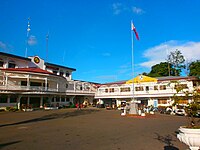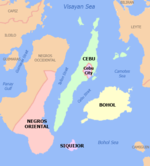world.wikisort.org - Philippines
Carcar, officially known as the City of Carcar (Cebuano: Dakbayan sa Carcar; Tagalog: Lungsod ng Carcar), is a 5th class component city in the province of Cebu, Philippines. According to the 2020 census, it has a population of 136,453 people. [3]
Carcar | |
|---|---|
Component city | |
| City of Carcar | |
 Carcar from the bell tower of St. Catherine of Alexandria church | |
 Map of Cebu with Carcar highlighted | |
OpenStreetMap OpenStreetMap  | |
 Carcar Location within the Philippines | |
| Coordinates: 10°07′N 123°38′E | |
| Country | Philippines |
| Region | Central Visayas |
| Province | Cebu |
| District | 1st district |
| Founded | 1599 |
| Cityhood | July 1, 2007 (Lost cityhood in 2008 and 2010) |
| Affirmed Cityhood | February 15, 2011 |
| Barangays | 15 (see Barangays) |
| Government | |
| • Type | Sangguniang Panlungsod |
| • Mayor | Mario Patricio P. Barcenas (1Cebu) |
| • Vice Mayor | Efren A. Quijano (1Cebu) |
| • Representative | Rhea Mae A. Gullas |
| • City Council | Members |
| • Electorate | 82,036 voters (2022) |
| Area | |
| • Total | 116.78 km2 (45.09 sq mi) |
| Elevation | 97 m (318 ft) |
| Highest elevation | 807 m (2,648 ft) |
| Lowest elevation | 0 m (0 ft) |
| Population | |
| • Total | 136,453 |
| • Density | 1,200/km2 (3,000/sq mi) |
| • Households | 32,075 |
| Economy | |
| • Income class | 5th city income class |
| • Poverty incidence | 13.80% (2018)[4] |
| • Revenue | ₱726,426,177.87 (2020) |
| • Assets | ₱3,250,519,321.36 (2020) |
| • Expenditure | ₱428,871,015.46 (2020) |
| • Liabilities | ₱1,096,285,903.63 (2020) |
| Service provider | |
| • Electricity | Cebu 1 Electric Cooperative (CEBECO 1) |
| Time zone | UTC+8 (PST) |
| ZIP code | 6019 |
| PSGC | |
| IDD : area code | +63 (0)32 |
| Native languages | Cebuano Tagalog |
Carcar City is bordered to the north by the town of San Fernando, to the west are the towns of Aloguinsan and Barili, to the east is the Cebu Strait, and to the south is the town of Sibonga.
Carcar lies within Metro Cebu area.[5]
History
Carcar was known as "Sialo" since before the Spanish colonization. It became a municipality in 1599. Carcar is considered one of the oldest towns in Cebu, with its Spanish influence lasted more than 300 years ago.
Cityhood
On July 2007, the municipality of Carcar was converted into a component city of the province of Cebu after ratification of Republic Act 9436.
On November 18, 2008, Supreme Court ruled that the cityhood charters of Carcar and 15 other cities as unconstitutional as a result of a petition filed by the League of Cities of the Philippines. A year later, on December 22, Carcar and 15 other municipalities regained their status as cities again after the court reversed its November 18, 2008, ruling. On August 23, 2010, the court reinstated its ruling on November 18, 2008, causing Carcar and 15 cities to revert back to municipalities. Finally on February 15, 2011, Carcar and the other 15 municipalities regained their cityhood status.
In 2013, after a six year legal battle, the League of Cities of the Philippines acknowledged and recognized the cityhood of Carcar and 15 other cities on July 19, 2013.[6][7]
Geography
Carcar is located 40 kilometres (25 mi) south of Cebu City. It has a land area of 116.78 square kilometres (45.09 sq mi).
- Topography
The land is generally level with less than 18% slope comprising 78.7% of the total land area. Areas with slopes ranging from 18 to 50% cover 19.3% of the total land area and those over 50% slope comprise approximately 1.9%. The highest recorded elevation is a little over 660 metres (2,170 ft) above sea level, located within the barangay of Napo.
- Soil type
The municipality has five dominant soil types namely: Faraon Clay, Steep Phase, the Lugo Clay, the Mandaue clay loam & the Hydrosol type.
Barangays
Carcar comprises 15 barangays:
| PSGC | Barangay | Population | ±% p.a. | |||
|---|---|---|---|---|---|---|
| 2020 [3] | 2010 [8] | |||||
| 072214001 | Bolinawan | 8.0% | 10,881 | 10,852 | 0.03% | |
| 072214002 | Buenavista | 2.0% | 2,662 | 2,294 | 1.41% | |
| 072214003 | Calidngan | 2.4% | 3,258 | 2,953 | 0.93% | |
| 072214004 | Can‑asujan | 6.7% | 9,114 | 7,845 | 1.42% | |
| 072214005 | Guadalupe | 9.3% | 12,641 | 10,633 | 1.64% | |
| 072214006 | Liburon | 5.6% | 7,606 | 6,749 | 1.13% | |
| 072214007 | Napo | 4.7% | 6,427 | 6,344 | 0.12% | |
| 072214008 | Ocaña | 6.9% | 9,361 | 8,507 | 0.91% | |
| 072214009 | Perrelos | 10.4% | 14,129 | 12,901 | 0.86% | |
| 072214012 | Poblacion I | 8.0% | 10,919 | 8,996 | 1.84% | |
| 072214013 | Poblacion II | 2.0% | 2,680 | 2,432 | 0.92% | |
| 072214014 | Poblacion III | 5.1% | 6,898 | 5,763 | 1.71% | |
| 072214015 | Tuyom | 4.5% | 6,080 | 5,563 | 0.84% | |
| 072214010 | Valencia | 4.0% | 5,485 | 4,885 | 1.10% | |
| 072214011 | Valladolid | 8.4% | 11,523 | 10,606 | 0.78% | |
| Total | 136,453 | 107,323 | 2.29% | |||
Climate
The wet season occurs during the months of May to October and the dry season, from January to May.
| Climate data for Carcar, Cebu | |||||||||||||
|---|---|---|---|---|---|---|---|---|---|---|---|---|---|
| Month | Jan | Feb | Mar | Apr | May | Jun | Jul | Aug | Sep | Oct | Nov | Dec | Year |
| Average high °C (°F) | 28 (82) |
29 (84) |
30 (86) |
31 (88) |
31 (88) |
30 (86) |
30 (86) |
30 (86) |
30 (86) |
29 (84) |
29 (84) |
28 (82) |
30 (85) |
| Average low °C (°F) | 23 (73) |
23 (73) |
23 (73) |
24 (75) |
25 (77) |
25 (77) |
25 (77) |
25 (77) |
25 (77) |
25 (77) |
24 (75) |
23 (73) |
24 (75) |
| Average precipitation mm (inches) | 70 (2.8) |
49 (1.9) |
62 (2.4) |
78 (3.1) |
138 (5.4) |
201 (7.9) |
192 (7.6) |
185 (7.3) |
192 (7.6) |
205 (8.1) |
156 (6.1) |
111 (4.4) |
1,639 (64.6) |
| Average rainy days | 13.4 | 10.6 | 13.1 | 14.5 | 24.2 | 27.9 | 28.4 | 27.7 | 27.1 | 27.4 | 22.5 | 15.9 | 252.7 |
| Source: Meteoblue (Use with caution: this is modeled/calculated data, not measured locally.)[9] | |||||||||||||
Demographics
| Year | Pop. | ±% p.a. |
|---|---|---|
| 1903 | 31,895 | — |
| 1918 | 37,392 | +1.07% |
| 1939 | 36,308 | −0.14% |
| 1948 | 32,818 | −1.12% |
| 1960 | 36,304 | +0.84% |
| 1970 | 45,806 | +2.35% |
| 1975 | 47,174 | +0.59% |
| 1980 | 57,822 | +4.15% |
| 1990 | 70,841 | +2.05% |
| 1995 | 78,726 | +2.00% |
| 2000 | 89,199 | +2.71% |
| 2007 | 100,632 | +1.68% |
| 2010 | 107,323 | +2.37% |
| 2015 | 119,664 | +2.09% |
| 2020 | 136,453 | +2.62% |
| Source: Philippine Statistics Authority [10] [8] [11][12] | ||
Economy
Tourism

- As a Heritage City of Cebu, Carcar contains various Spanish and American period structures. The Carcar plaza alone hosts several heritage structures, the Church of St. Catherine of Alexandria dominates the area. Within the complex various structures stand, including quaint houses and their distinctive architectural details.
- Surrounding the Rotunda and in the public market one will find the famous Carcar chicharon, lechon, ampao, bucarillo, gorgorias and puso – just some of the local delicacies.
- Guadalupe Mabugnao Mainit Hot Spring National Park
- Heritage Houses such as the Mercado Mansion
- Tuyom Beach – Beach Houses
- The Kabkaban Festival, which is the town's local festival in honor of St. Catherine of Alexandria. The name of the festival comes from the old name of the town, which was taken from the local term for the Oakleaf Fern (Aglaomorpha quercifolia) which is abundant in the town, even to this day. Celebrated from the November 23 to 25, it highlights the rich culture, faith, and musical history of Carcar.
Notable personalities
- Msgr. Teofilo Bastida Camomot – founded the Congregation of Blessed Virgin Missionaries
- Sheryn Regis – singer
Gallery
- Rizal Monument at Town Plaza
- Carcar City Museum (formerly, Carcar Dispensary)
- Carcar Church Interior
- Carcar Town Complex
References
- City of Carcar | (DILG)
- "2015 Census of Population, Report No. 3 – Population, Land Area, and Population Density" (PDF). Philippine Statistics Authority. Quezon City, Philippines. August 2016. ISSN 0117-1453. Archived (PDF) from the original on May 25, 2021. Retrieved July 16, 2021.
- Census of Population (2020). "Region VII (Central Visayas)". Total Population by Province, City, Municipality and Barangay. PSA. Retrieved July 8, 2021.
- "PSA Releases the 2018 Municipal and City Level Poverty Estimates". Philippine Statistics Authority. December 15, 2021. Retrieved January 22, 2022.
- Sun–Star 2005.
- "16 new cities recognized as LCP members (Archived)". Sun Star News. July 19, 2013. Retrieved March 6, 2018.
- "League finally recognizes 16 'unqualified' cities". Rappler. July 19, 2013. Retrieved March 6, 2018.
- Census of Population and Housing (2010). "Region VII (Central Visayas)". Total Population by Province, City, Municipality and Barangay. NSO. Retrieved June 29, 2016.
- "Carcar: Average Temperatures and Rainfall". Meteoblue. Retrieved May 10, 2020.
- Census of Population (2015). "Region VII (Central Visayas)". Total Population by Province, City, Municipality and Barangay. PSA. Retrieved June 20, 2016.
- Censuses of Population (1903–2007). "Region VII (Central Visayas)". Table 1. Population Enumerated in Various Censuses by Province/Highly Urbanized City: 1903 to 2007. NSO.
- "Province of Cebu". Municipality Population Data. Local Water Utilities Administration Research Division. Retrieved December 17, 2016.
- "Poverty incidence (PI):". Philippine Statistics Authority. Retrieved December 28, 2020.
- https://psa.gov.ph/sites/default/files/NSCB_LocalPovertyPhilippines_0.pdf; publication date: 29 November 2005; publisher: Philippine Statistics Authority.
- https://psa.gov.ph/sites/default/files/2003%20SAE%20of%20poverty%20%28Full%20Report%29_1.pdf; publication date: 23 March 2009; publisher: Philippine Statistics Authority.
- https://psa.gov.ph/sites/default/files/2006%20and%202009%20City%20and%20Municipal%20Level%20Poverty%20Estimates_0_1.pdf; publication date: 3 August 2012; publisher: Philippine Statistics Authority.
- https://psa.gov.ph/sites/default/files/2012%20Municipal%20and%20City%20Level%20Poverty%20Estima7tes%20Publication%20%281%29.pdf; publication date: 31 May 2016; publisher: Philippine Statistics Authority.
- https://psa.gov.ph/sites/default/files/City%20and%20Municipal-level%20Small%20Area%20Poverty%20Estimates_%202009%2C%202012%20and%202015_0.xlsx; publication date: 10 July 2019; publisher: Philippine Statistics Authority.
- "PSA Releases the 2018 Municipal and City Level Poverty Estimates". Philippine Statistics Authority. December 15, 2021. Retrieved January 22, 2022.
Sources
- Sun–Star (October 8, 2005). "RDC enlarges Metro Cebu". Archived from the original on September 30, 2007. Retrieved November 10, 2015.
External links
 Media related to Carcar at Wikimedia Commons
Media related to Carcar at Wikimedia Commons Carcar travel guide from Wikivoyage
Carcar travel guide from Wikivoyage- Philippine Standard Geographic Code
На других языках
[de] Carcar
Carcar (offiziell: City of Carcar; Cebuano: Dakbayan sa Carcar, Filipino: Lungsod ng Carcar) ist eine philippinische Stadt (Component City) in der Provinz Cebu.- [en] Carcar
[it] Carcar (Cebu)
Carcar è una municipalità di prima classe delle Filippine, situata nella Provincia di Cebu, nella Regione del Visayas Centrale.Другой контент может иметь иную лицензию. Перед использованием материалов сайта WikiSort.org внимательно изучите правила лицензирования конкретных элементов наполнения сайта.
WikiSort.org - проект по пересортировке и дополнению контента Википедии





